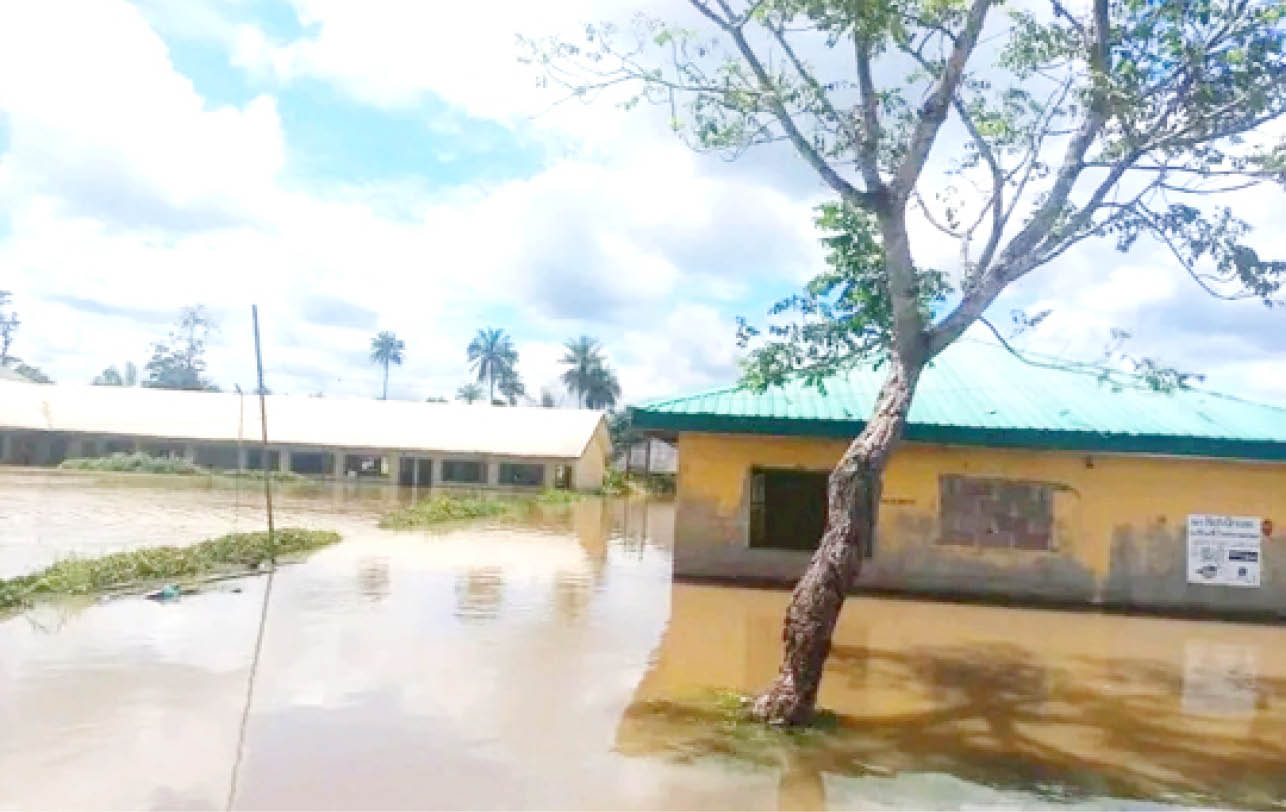Find lasting solution to flood
Every year, Cameroonian authorities release excess water from the Lagdo Dam, water which flows into Nigeria through the River Benue, which coupled with rainfall around the same period, leads to flooding in the country. Yesterday, the National Inland Waterways Authority (NIWA) issued a warning to all those living around river banks to relocate, due to […]

FILE PHOTO:
Girls Secondary School, Kaiama, Kolokuma Opokuma LGA being overrun by flood water
Every year, Cameroonian authorities release excess water from the Lagdo Dam, water which flows into Nigeria through the River Benue, which coupled with rainfall around the same period, leads to flooding in the country. Yesterday, the National Inland Waterways Authority (NIWA) issued a warning to all those living around river banks to relocate, due to floods. This is as the NEMA bulletin placed states on the banks of rivers Benue and Niger – Adamawa, Taraba, Benue, Niger, Nasarawa, Kebbi, Kogi, Edo, Delta, Anambra, Cross River, Rivers and Bayelsa – on red alert.
The situation is made worse by the fact that the Nigerian government seems helpless in putting a stop to this annual conundrum. Due to the failure of town planning and enforcement of laws, many have converted flood planes to residences, building all sorts of structures on water channels.
According to the Director General of the National Emergency Management Agency (NEMA), Mustapha Ahmed, 662 people lost their lives, 3,174 others suffered injuries and 2,430,445 individuals were displaced by the floods in 2022. He added that thousands of houses, hectares of farmlands and several critical national assets were also destroyed by the raging floods.
Ten years earlier, in 2012, no fewer than 360 people were killed and 2.1 million others displaced. In 2018, over 200 people were killed and 100,000 were displaced and many hectares of farmlands and crops were destroyed by flood.
Jega, Mbari lead ECOWAS, AU pre-election fact-finding mission to Liberia
How biofilms on hospital equipment pose risk in healthcare
It is rather unfortunate that despite the fact that flooding has become an annual occurrence, nothing tangible has been done to stop it or reduce its effect on the people. This annual, nay disastrous routine must not be allowed to continue. It is time the Nigerian government found a lasting, sustainable and permanent solution to this problem so as to save lives, properties and farmlands. We cannot continue to warn people or wait until disaster strikes to provide palliatives which either do not get to the actual victims or are not enough.
It is not as if we have a shortage of solutions, as several reports have been submitted in the past on the floods. The only snag is implementation.
For instance, in a paper presentation titled ‘River Benue and Lagdo Dam in Cameroon: Sources of Water Conflict, Excess Floods, Poverty and Food Insecurity in Nigeria’ by Dr Asriel, Akuso George, a geologist and environmental resource manager and made available to this paper, some suggestions and solutions that will mitigate the effects of the excess water from the Lagdo Dam were put forward.
“Nigeria,” he said, “receives the excess flood water from Cameroon of 3,477m3/second at the River Benue (an equivalent of 6,195,600 litres of water/second or 1,636,882.43 gallons/sec.)
“To ameliorate this problem, a receptor dam [should] be constructed on the entry point downstream of Rivers Tiel and Faro (in Fufore Local Government Area, Adamawa State) to divert the excess flood water in the Benue by about 18,220,611,000,000 litres in the 3rd week of August to the 2nd week of September to enable the excess water to move by gravity for a distance of 408 kilometers into the wetland area of the Lake Chad inside Nigeria measuring 607,353.7 hectares, to be excavated to a depth of 3 meters to store the excess water for agriculture and fishery.
“A volume water of 18,220,611,000,000 litres would be transferred as an Interbasin Water Transfer from River Benue (in Adamawa State) to the Wetland Area of the Lake Chad inside Nigeria) to resuscitate the dying Lake Chad inside Nigeria, by adopting the Interbasin Water Transfer Principles of taking excess water (Adamawa State being the point “Excess”) to the Lake Chad Basin inside Nigeria (being the point of “Need”).
He further said adopting the principles of an Inter-basin-water transfer will solve three problems at a time to: (1) Reduce the excess flooding in the country generally and in Adamawa State to be precise; (2) Transfer the excess flood water of over 18,220,611,000,000 litres through a canal measuring 30m x 2.0m x 408 km to resuscitate the dying Lake Chad; (3) The 18,220,611,000,000 litres would cover Nigeria’s international boundary line with Niger (75.62km), Chad (85km) and Cameroon (325km), which are now open and are being the unguarded boundary line of 475.62 kilometers.
This is one indication that we do not lack experts in the field who can proffer solutions to the problem. We call on the federal government to consider bringing together all experts in the profession to brainstorm and come up with ideas that can help save the situation. We cannot continue to manage the situation. This should also be seen as a national security issue which all relevant government agencies must key into. NEMA and the National Inland Waterways Agency (NIWA), Nigeria Hydrological Service Agency (NIHSA) etc, should work together to come up with a lasting solution to this recurring national emergency.
